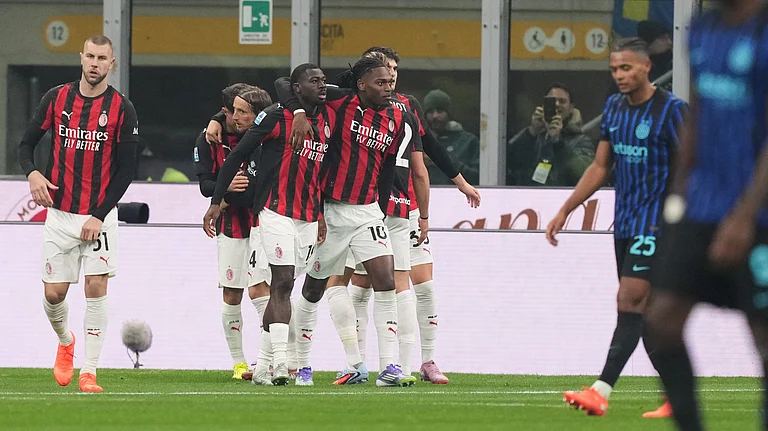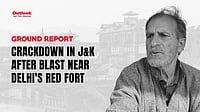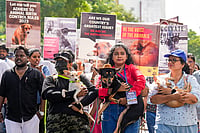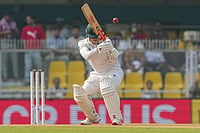Even on April 6, the polling day, Lord Ayyappa dominated the headlines in God’s own country. Sabarimala has been a prominent issue throughout the month-long intense campaign for the assembly polls, and the raging debate exposed deep divisions on religious lines once again. If the war of words between the ruling Left Democratic Front (LDF) and the opposition parties over women’s entry into Sabarimala temple was anything to go by, whoever emerges the winner on May 2 has a tough task at hand. Though many aspects of the election will be pondered in the days ahead, the religio-sectarian narratives will be discussed the most—among them the verbal attack by opposition parties on chief minister Pinarayi Vijayan over his government’s decision to facilitate entry of women of all ages into the hill shrine at Sabarimala following the 2018 Supreme Court order.
This election is crucial for all three main players—the CPI(M)-led LDF, the Congress-led United Democratic Front (UDF) and the BJP-led National Democratic Alliance (NDA). In the 2016 assembly election, the LDF romped home with 91 of the total 140 seats and the UDF bagged 47, while the BJP won its first-ever seat in the state. If the LDF government returns to power, it will be breaking the 44-year-old tradition of the LDF and the UDF replacing each other at the helm of the state government after every five years. As several pre-poll surveys predicted a return of the LDF government, the Congress and the BJP have pulled out all stops to prevent the ruling front from winning the election. No wonder Sabarimala became the major poll plank of the UDF and the NDA, both of which aimed to show the CPI(M) in poor light. Both fronts have proposed legislation to ban women’s entry into the temple. In its draft, the Congress even proposed to punish those who violate the temple’s traditions.
ALSO READ: Kazhagam Of Appeals
In the initial phase of the campaign, it seemed the election would be a walkover for the LDF, say poll analysts. However, it became a see-saw battle in many assembly constituencies across the state, says D. Dhanuraj, chairperson of the Kochi-based Centre for Public Policy Research (CPPR). “Though the Congress was in disarray in the initial phase, it pulled itself up from the abyss. The party, which was lagging behind the LDF because of internal rift, picked up momentum after Rahul and Priyanka Gandhi visited the state,” he adds.
The Sabarimala factor may work in favour of the UDF and the NDA at least in some seats in the southern part of Kerala, where a tight contest is on the cards. According to Dhanuraj, the impact is likely to play out in Thiruvananthapuram, Kollam and Pathanamthitta districts, where the LDF won 10 out of the 14 assembly segments in the 2016 elections. However, observers also point out that the decisive factor would have been 10 to 15 per cent of the electorate comprising “neutral voters”. “Neutral voters could have changed their minds at the last minute. We don’t know what they decided,” says K.M. Sajad Ibrahim, professor of political science at the University of Kerala, Thiruvananthapuram. “Though people tell us they supported the government, they also wanted change. That’s the attitude of the people of Kerala. But if they didn’t change their mind, that would be to the LDF’s advantage.”
ALSO READ: Pens Against The Tide

Voters being ferried to a booth display their voter IDs
The BJP had pinned its hope on a few seats such as Nemom, Thiruvananthapuram and Kazhakkoottam, where it projected Sabarimala as the main plank. In Kazhakkoottam, BJP vice president Sobha Surendran was pitted against Devaswom minister Kadakampally Surendran. For the BJP, Kadakampally Surendran’s regret over the 2018 Sabarimala-related events had come as a major boost. “The Sabarimala issue would have benefited the BJP in Kazhakkoottam,” says Dhanuraj. Pathanamthitta, the ground zero of Sabarimala, is another district where the BJP was looking to gain in a big way. BJP state president K. Surendran, who contested the Konni assembly seat, was cashing in on his party’s promise to protect people’s faith. On election day, Nair Service Society general secretary Sukumaran Nair’s scathing criticism of the LDF government on the Sabarimala issue came as a shot in the arm for both the BJP and the Congress.
According to observers, central Kerala also observed a fierce contest. Though political equations in the region have changed after the Kerala Congress (M) led by Jose K. Mani crossed over to the LDF, its impact won’t be felt much, say commentators. Other factors such as the feud between the Orthodox and Jacobite factions of the Malankara Church and the BJP raising the love jihad bogey to woo the churches would have an impact on May 2, they say.
A few weeks before the election, one narrative that came to prominence among certain sections was that if the CPI(M) led by Pinarayi Vijayan gets a second term in office, Kerala will be “doomed” and there will be a “repeat of West Bengal or Tripura”. According to writer and analyst N.S. Madhavan, such arguments underestimate the public and the political parties. “I don’t understand why a section of people has started such a discussion. Before 1982, we had governments that repeated their tenure. There is a fundamental difference between Kerala, on the one hand, and West Bengal and even Tripura, on the other. It is not an organic way of thinking that the party will be doomed if it gets re-elected,” says Madhavan.
While the opposition parties have tried to shift the political narrative from development to religious faith, CPI(M) leaders say the economic model followed by the LDF government will be emulated by other states in the future. The ruling party was also buoyed by the stunning victory in recent local body elections. CPI(M) leader and former state education minister M.A. Baby says his party is confident that the LDF will win the election and form the government again. “We are confident of a second term because of the welfare schemes and development initiatives implemented by the LDF government,” he says.
The CPI(M) also banked heavily on the ‘strong man’ image of Pinarayi Vijayan and the LDF campaign was mostly centred on him. The party believes the LDF government’s effective handling of many crises—cyclone Okhi, the Nipah outbreak, two consecutive floods and the Covid pandemic—has worked to its advantage. “Now the poor and the middle class look up to Pinarayi Vijayan as he handled the crisis situations in a brilliant way,” says Ibrahim. Government programmes such as welfare pension, free ration kits and free housing through the Life Mission project have also captured the imagination of the people. “Food and livelihood are fundamental rights, and during the crisis situations, the government intervened effectively to provide food and shelter for the poor,” says Baby. “No governments run by the BJP or the Congress offer free Covid treatment or free tests. While stating their economic policies, both Narendra Modi and Rahul Gandhi said there is no free lunch.”
Madhavan, however, is critical of the model followed by the Kerala government. “The basic strength of the Kerala model was people-oriented. Now it has become more infrastructure-oriented. When we talk about schools, we are thinking more about buildings than the quality of education. I feel there is a need for reorientation on that,” he says.
By Preetha Nair in Kochi


























